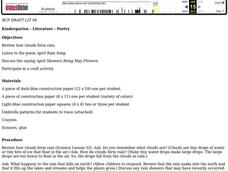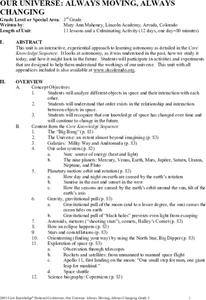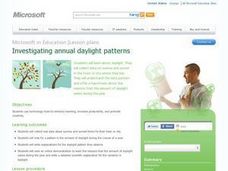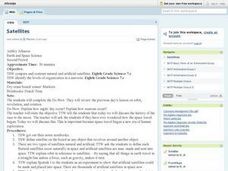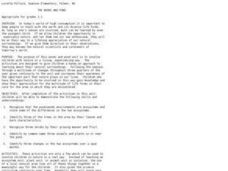Curated OER
How Warm is the Water?
Students research how surface sea temperature changes throughout the year. They draw a time series of sea surface temperatures for each month of the year and a depth profile for a summer and winter month using an OceanExplorer Profiler...
Curated OER
Climatic Changes
For this climate changes worksheet, students review the different events such as volcanic eruptions and El Nino that change the climate. This worksheet has 5 multiple choice and 5 short answer questions.
Curated OER
Poetry
Students review how clouds form rain, listen to the poem April Rain Song, discuss the saying April Showers Bring May Flowers, and participate in a craft activity.
Curated OER
Constructing a Planetarium
Learners work together to create their own planetarium. They observe the night sky and make a design. They also examine constellations and paint them onto the model of the planetarium.
Curated OER
Our Universe: Always Moving, Always Changing
Students explore the main concepts of astronomy through the eleven lessons of this unit. The past, present, and future methods of studying the science are examined in this unit.
Curated OER
Graphing San Diego Tides
Students observe the tides in San Diego for one month. Using this information, they graph the tides on a chart along with the phases of the moon. They answer questions related to the graph to end the lesson.
Curated OER
When is Dinner Served? Predicting the Spring Phytoplankton Bloom in the Gulf of Maine (College Level)
Students are able to explain the ecological importance of phytoplankton. They describe the components that influence a phytoplankton bloom. Students interpret satellite images in order to correlate buoy data.
Curated OER
Sea Surface Temperature Trends of the Gulf Stream
Students explore the importance of the Gulf Stream. Using a NASA satellite images, they examine the sea surface temperature. Students collect the temperature at various locations and times. Using spreadsheet technology, they graph the...
Curated OER
Measuring the Diameter of the Sun
Students calculate and measure the diameter of the sun. They construct a meter stick instrument, calculate the diameter using a formula, and compare the measurement with the accepted scientific measurement.
Curated OER
Watershed Management
Students investigate the concept of a watershed. They conduct research into the concept using a variety of resources. Students take a field trip to a local watershed to make observations. The outcome is a report concerning the outside...
Curated OER
The Woods and Pond
Pupils participate in hands-on activities to explore their natural surroundings. They recognize that ponds and woods are ecosystems and compare differences between the two. They identify trees by their bark and leaves.
Curated OER
Agriculture, Weather, Economy and Indiana
Fourth graders, in groups, investigate the role of weather in Indiana's farming economy. They make a prediction as to weather and its effect on the economy of Indiana. They present their data using a media presentation of data...
Curated OER
Temperature Comparisons
Students practice plotting temperature data points on a line graph in groups and examine the temperature differences at the same time of year. They graph the temperatures in Lannon, WI, and Mitchell's Plain, SA. After the data has been...
Curated OER
Water Management
Learners investigate the plan of a community water management plan. They are given the roles of community members who are involved in a meeting to discuss the development of a plan to conserve water and preserve resources of water.
Curated OER
Investigating daylight
learners investigate a natural factor affecting their everyday lives: daylight. First, they collect data on sunrise and sunset in their hometown, create a Microsoft Office Excel chart to help them understand the data pattern, and offer a...
Curated OER
RIDE THE WILD LEAF
Students identify and interpret that leaves provide food for new trees and plants. Students cut out leaves and glue them on the appropriate
number on included worksheet. Students collect different types of leaves and make leaf rubbings....
Curated OER
Blowing in the Wind
Students identify and interpret maps, graphs, charts, tables and political cartoons. Students identify what a compass rose is and review its meaning in relation to standard directions. Students design their own weathervanes. Students...
Curated OER
Satellites
Eighth graders explore the history of space travel and satellites. Through a teacher demonstration, 8th graders observe how a satellite revolves another object. They identify natural and artificial satellites, explore how satellites...
Curated OER
Where Have All the Road Salts Gone, Long Time Migrating
Students examine what happens to road salt after it is applied to the road during a storm. In groups, they collect their samples using a conductivity meter and enter their data into a database. They analyze and discuss the data...
Curated OER
Mineral Munch
Second graders explore the sodium content in foods they eat. After observing a table setting, 2nd graders then identify items made from rock. They taste low sodium crackers and compare them to regular crackers. Students discuss the...
Curated OER
The Woods and Pond
Students explore nature in a living, experiencing way. In this woods and ponds lesson plan, students recognize that ponds/woods environments are ecosystems, identify three of the trees in the area by their leaves and bark...
Other popular searches
- Seasons, Earth's Axis
- Smart Board Earth's Seasons
- Season's Earth's Rotation
- What Causes Earth's Seasons
- Earth's Seasons Quiz
- Cause of Earth's Seasons
- Seasons Earth's Axis
- Earth's Seasons Vocabulary
- Earth's Seasons Flashlights
- Seasons Earth's Tilt
- Science Earth's Seasons
- Seasons Earths Orbit




